Thursday, March 31, 2011
Washington Post Misleading on Michigan Redistricting
Maxed out in Michigan - The Fix - The Washington Post
The article discusses various scenarios for how redistricting will play out. It claims that Republicans face a problem because they are "maxed out" and will have difficulty eliminating a democrat seat and holding their own. Blake hardly notes that demographic shifts are extremely favorable for Republicans.
The fundamental error this piece makes is to use President Obama's 2008 performance as a benchmark for how Republican or democratic a district is. But this is unreasonable. Because John McCain publicly abandoned the state weeks before the election, some conservative and independent voters refused to vote for him. Others may have gone to Obama, swelling his margin.
Obama's performance is the absolute high water mark for democrats, and is totally out of line with local elections in Michigan for decades. For this reason, I don't use it, or measures based on it, like the Cook ratings, for analyzing Michigan elections. I prefer to use Michigan state house elections, since they are local and have frequent open seats.
For example, Obama won Michigan's 6th district. Is Republican Congressman Fred Upton endangered? Democrats have only one of 7.5 state house seats in the 6th. This has not changed in many decades. There is no reason to think that the 6th district is vulnerable. Similar analyses apply to most other Republican districts.
Blake notes that the conventional wisdom is that democrats Gary Peters and Sander Levin will end up in the same district. The conventional wisdom is correct. This is simply the only reasonable option for Republicans.
Blake notes that the Detroit districts may have to extend into Oakland County. But the Michigan Supreme Court has ruled that guidelines on County breaks are not enforceable.
Blake notes the curious decision of state rep Marty Knollenberg to run for Congress. But just because he sits on the redistricting committee doesn't mean he runs the committee. I'm not sure how he thinks he will have a district to run in. He will probably end up in the same district as either Peters/Levin or Thaddeus McCotter. It would make a lot more sense for Knollenberg to run for state senate in 2014, when John Pappageorge will be term-limited.
Blake mentions other possibilities.
Combining Peters and McCotter is insane unless it is a heavily Republican district.
Breaking up Dale Kildee's district can't work because no neighboring Republican district can take on Flint.
Combining Kildee and Peters wouldn't work since they aren't adjacent, and most of the democrats are at the southern end of Peters' district.
Breaking up Dingell isn't practical for the reasons that Blake mentions.
Blake is overthinking things. This blog has already demonstrated that it is easy to draw a map that combines Peters and Levin and shores up Walberg, Benishek, and McCotter. The only question is whether Republicans should go for more.
Michigan Congressional Redistricting: Two Possible Maps
Sowell on the Census and Detroit: Brilliant!
Voting With Their Feet
Read the whole thing.
Detroit is perhaps the most striking example of a once thriving city ruined by years of liberal social policies. Before the ghetto riot of 1967, Detroit's black population had the highest rate of home-ownership of any black urban population in the country, and their unemployment rate was just 3.4 percent.
It was not despair that fueled the riot. It was the riot which marked the beginning of the decline of Detroit to its current state of despair. Detroit's population today is only half of what it once was, and its most productive people have been the ones who fled.
Treating businesses and affluent people as prey, rather than assets, often pays off politically in the short run--and elections are held in the short run. Killing the goose that lays the golden egg is a viable political strategy.
As whites were the first to start leaving Detroit, its then mayor Coleman Young saw this only as an exodus of people who were likely to vote against him, enhancing his re-election prospects.
But what was good for Mayor Young was disastrous for Detroit.
There is a lesson here somewhere, but it is very doubtful if either the intelligentsia or the politicians will learn it.
Tuesday, March 29, 2011
Kalamazoo Hispanic Council Defends Criminals
Immigration raids put Kalamazoo's Hispanic American Council 'in crisis mode'
KALAMAZOO — The Hispanic American Council, the Kalamazoo area’s largest Latino advocacy group, is operating “in crisis mode” in the wake of a series of arrests of undocumented immigrants made this week by federal immigration agents, a top official at the council said.Oh no! How could they! CRISIS! CRISIS!
Many in the Hispanic community in the city of Kalamazoo are closing up their shops, keeping their kids home from school and holding-up in their homes, said Lori Mercedes, program director at the council.
“Of course they are afraid,” Mercedes said of the state of mind of Hispanic community members. “We must see the human aspect of what happens when ICE (U.S. Immigration and Customs Enforcement) comes into our community.”
The operation, carried out at businesses and residences from Sunday through Wednesday, arrested 20 male illegal immigrants who were either guilty of a crime or had been told to leave the country but had failed to do so. Of the 20 arrested, 15 were from Mexico; others were from Nigeria and China.
Arrests were made at the Big Burrito on KL Ave., and Stir Max and Olive Garden, both on Westnedge Avenue, Mercedes said.More jobs for Americans.
Phillip Cruz, program coordinator at the council, said it might be true that some of those arrested were criminals, but that others arrested by ICE were simply in the wrong place at the wrong time.And they were criminals. Illegal immigration is a crime.
For instance, Cruz said, when ICE agents made their way to Big Burrito, the individual they were looking for was not there. So agents began questioning other workers there. After determining that one of them was undocumented, that man was arrested.Good riddance.
The same circumstance took place at homes in the community, Cruz said.
ICE told the Kalamazoo Gazette on Thursday that the operation was targeted to illegal immigrant criminals and those who had not complied with federal demands to leave the country.
However, according to Khaalid Walls, spokesman for the ICE field office in Detroit: “In general, when conducting operations if we run into individuals who are not part of our operational scope but are here illegally we have the authority to arrest them.”
Mercedes also had serious concerns about the way ICE agents handled their investigations while in the city.
After speaking with several members of the Hispanic community who had interactions with ICE agents while the operation was occurring, Mercedes alleged that agents harassed and intimidated people who had done nothing wrong.
Some were stopped in the streets, she said, adding that the operation lasted much longer than past ICE operations in the city, which usually lasted one to two days.
“The process is full of intimidation,” she said. “There is a fear right now that they can be caught anywhere. A lot will pack up and move away. Enough is enough.”
Mercedes said that she would be organizing an effort to investigate claims of wrongdoing by ICE. The council, she said, would be in contact with the American Civil Liberties Union to explore its legal options.I'm sure criminals report lots of crimes to the police.
But a more immediate negative result of the operation is the possibility that the fear it created will keep Hispanic members of the community from reporting crimes to Kalamazoo Department of Public Safety officers, she said.
Bridges of trust between KDPS and the more than 5,000 member Hispanic community that have been built over several years can be destroyed as a result of an operation like the one that took place, Mercedes said.You have the right to remain silent...
“We need to make a distinction between Public Safety and ICE,” she said. “Public Safety is here to enforce and protect the community. Our community needs to know they still have rights even if they are undocumented.”
The comments on this article are extremely unsympathetic. Not a single one defends the illegals or the Hispanic Council.
Monday, March 28, 2011
POLITICAL UPDATE--Libya
Ann Coulter: Obama Cried, Kids Died
Pat Buchanan: Obama's War
Dan Flynn: The Right Must Admit It Was Wrong About Democracy in the Middle East
Mark Steyn: The Art of Inconclusive War
Pat Buchanan: Obama's Foolish and Unconstitutional War
Pat Buchanan: Obama’s Confused Foreign Policy—And America’s
Pat Buchanan: After The Arab “Revolution”, The Bell Tolls For America
Pat Buchanan: It's Their War, Not Ours
POLITICAL UPDATES are archived here.
Saturday, March 26, 2011
Michigan Congressional Redistricting: Two Possible Maps
Federal law mandates that congressional districts must have population as equal as possible. Michigan will drop from 15 to 14 districts, each of which must have 705,974 or 705975 people. Republicans currently have a 9-6 majority in the congressional delegation.
The Voting Rights Act, as interpreted by the courts, requires that black and Hispanic majority districts be drawn when reasonably possible. In Michigan, there must be two black-majority districts in the Detroit area.
State standards require that districts be contiguous by land with no cut-points. It also requires that there not be unreasonably many breaks of counties and cities/townships. However, the Michigan Supreme Court ruled in the case LaRoux v. Secretary of State (2001) that these standards cannot bind future legislatures, as any new redistricting plan passed into law would supersede the old law.
Drawing a map favorable to your party requires two basic things.
1. Pack your opponents into as few districts as possible.
2. Spread your supporters evenly to create modest majorities in as many districts as possible.
Point two has two further implications.
2a. Add more of your supporters to any vulnerable districts that you have.
2b. Remove some of your supporters (or add some of your opponents) to any districts where you have large majorities.
Further considerations include protecting the residences and constituencies of incumbents and removing or weakening the bases of potential challengers. They can also include matching constituents and representatives by class, race, etc.
How does this apply to Michigan? Democrats currently hold five districts in the Detroit area and one based in Flint. One of these (Gary Peters in Oakland County) is a swing district and the others are solidly democratic. All of these districts need to gain significant population, particularly the Detroit-based districts. It will not be difficult to consolidate the Detroit-area democrats down to at most four districts. This is most easily accomplished by carving the Republican areas off of Gary Peters’ district.
The currently vulnerable Republican districts are 1, 7, and 11, held by Dan Benishek, Tim Walberg, and Thaddeus McCotter, respectively.
Benishek can be made somewhat safer by adding Grand Traverse (County) and neighboring areas and removing north Bay. Walberg can be strengthened by removing some combination of Battle Creek, Eaton, and west Washtenaw. Losing Battle Creek is particularly important for Walberg since it is the home and political base of former congressman and potential future opponent Mark Schauer, who Walberg defeated in 2010. He could add either Republican territory in the Ionia/Clinton area or swing territory in Monroe County. McCotter would benefit from more territory in Oakland County.
The Republican districts that have more Republicans than necessary are 2, 3, and 10, held by Bill Huizinga, Justin Amash, and Candice Miller, respectively.
The only way to made Huizinga’s district substantially more democratic is to add some of the city of Grand Rapids. Amash could take on Battle Creek. Miller could take on swing areas in south Macomb including St. Clair Shores, south Sterling Heights, and north Clinton Twp.
I have drawn two different maps for how these goals might be accomplished. The first could be called the “max Republican” plan, since the primary goal is too elect as many Republicans as possible and it is only secondarily concerned with maintaining the existing constituencies of Republican incumbents. It is a 9-4-1 plan, where the 1 is an open swing district.
The key to this plan is Dale Kildee’s Flint-based 5th district. It already has some Republican areas in Tuscola and south Genessee. It needs to add population, but there are no adjacent democrat areas. The solution is to excise the Republican areas plus dem-leaning south Bay so that it can add Ingham, with Shiawassee as a connector. This removes the only democrat area from Mike Rogers’ 8th district, which allows him to take on Ann Arbor.
Meanwhile, the two Detroit districts push up into the democrat areas of Oakland and Macomb. John Conyers, Sander Levin, and Gary Peters all end up in the same district. John Dingell and Hansen Clarke both have their own districts. Thaddeus McCotter would have to choose between moving to a safe district in Oakland or running in a new swing district composed of west Wayne, east Washtenaw, and Monroe.
Tim Walberg would lose Battle Creek and west Washtenaw and add Clinton, Gratiot, and Montcalm.
Here are maps, made using Dave’s Redistricting App. Note that since this program had not yet been updated with 2010 census numbers, I had to hand-add the populations for the first map. Hence they are not exact, but should be within 10,000 of the ideal size. The boundaries can be tweaked as necessary to make the populations exact.
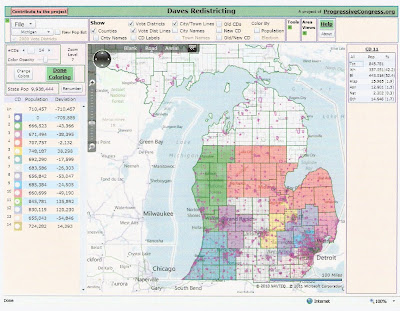
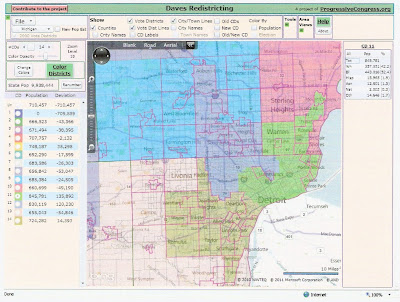
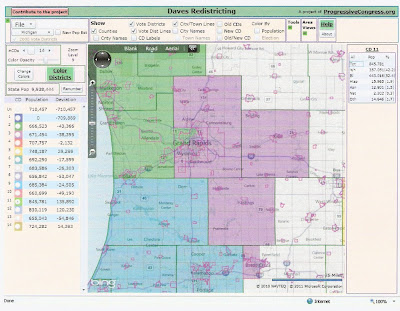

Brief Descriptions:
1. Benishek (R) Upper Peninsula, northern lower peninsula. Adds Grand Traverse, Kalkaska, Leelanau, Benzie. Loses Ogemaw, Gladwin, Arenac, north Bay.
2. Huizinga (R) West Michigan coast. Adds part of Grand Rapids. Loses north Allegan, Benzie.
3. Amash (R) Most of Kent, Ionia, Barry. Adds Battle Creek area. Loses part of Grand Rapids.
4. Camp (R) Central lower peninsula. Adds Ogemaw, Gladwin, Arenac, Bay, Tuscola, Huron, Sanilac. Loses Grand Traverse, Kalkaska, Leelanau, Montcalm, Gratiot, north Shiawassee.
5. Kildee (D) Flint area, Ingham, Shiawassee, city of Saginaw. Adds Ingham, Shiawassee. Loses Tuscola, south Bay, south Genessee.
6. Upton (R) Southwest Michigan. Adds north Allegan.
7. Walberg (R) South-central Michigan. Adds Clinton, Gratiot, Montcalm. Loses Battle Creek, west Washtenaw.
8. Rogers (R) Livington, Lapeer, north Oakland, south Genessee, Ann Arbor. Adds Lapeer, south Genessee, Ann Arbor. Loses Ingham, Clinton, south Shiawassee.
9. Open or McCotter (R) Southwest and east-central Oakland.
10. Miller (R) North Macomb, St. Clair. Adds St. Clair Shores, south Sterling Heights, part of Clinton Twp. Loses Huron, Sanilac, Lapeer.
11. Clarke (D) east Detroit, south Macomb. Adds south Macomb. Loses some of Downriver.
12. Conyers, Levin, Peters (D) west Detroit, southeast Oakland, including Pontiac, Southfield, and Royal Oak.
13. Open or McCotter (swing) west Wayne, east Washtenaw, and Monroe.
14. Dingell (D) Central Wayne, including Downriver, Dearborn, Westland. Adds Downriver, Westland. Loses Monroe, Ann Arbor.
The upsides of this map include a potential 10-4 delegation and eliminating two of Conyers, Levin, and Peters. The downside is that Camp, Rogers, and McCotter may not be very happy with how their districts are changed.
Now we consider a second plan. This could be called an incumbent protection plan, in that all the incumbents get safe districts, except that Peters and Levin are merged into one district. (Also, Walberg is not quite as safe as I would like.) This would create a 9-5 delegation.
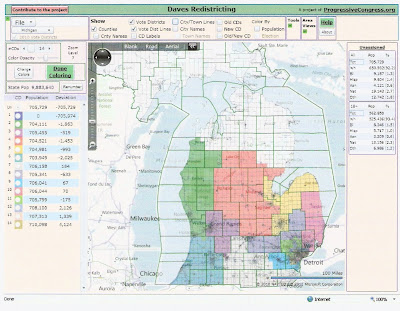
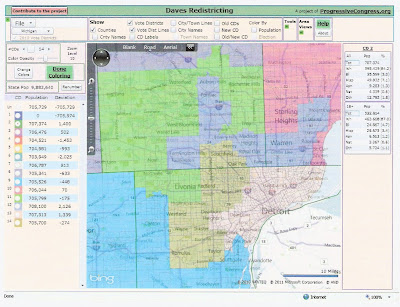
Descriptions:
1. Almost same
2. Almost same
3. Almost same
4. Camp. Adds Clinton, south Shiawassee, Gladwin, Arenac. Loses Grand Traverse, Kalkaska, Leelanau.
5. Kildee. Genessee, Bay, Tuscola, Huron, city of Saginaw. Adds north Bay, Huron.
6. Same
7. Walberg. Adds Monroe. Loses Battle Creek area, central Washtenaw.
8. Rogers. Adds Lapeer. Loses Clinton, south Shiawassee.
9. Dingell (renumbered from 15) Adds west Wayne, part of Downriver. Loses Monroe, central Wayne.
10. Miller. Adds St. Clair Shores, south Sterling Heights. Loses Huron, Lapeer.
11. McCotter. Adds Waterford, West Bloomfield, Rochester, Troy. Loses Redford, Westland, Canton.
12. Levin/Peters. South Macomb, Royal Oak, Pontiac, Bloomfield, Farmington.
13. Clarke. East Detroit. Adds Dearborn, central Detroit.
14. Conyers. West Detroit, Southfield, Oak Park, Westland, Romulus, Taylor. All but Detroit are additions. Loses part of Downriver.
Which map do you prefer?
Friday, March 25, 2011
State Shutters Stadium Speed Trap
Speed limit on Stadium Drive to be raised; MDOT to hold public meeting to explain increase
It should really be 50, but this is a major improvement. A previous Gazette report showed that Stadium was one of the biggest speed traps in Kalamazoo. This is a sign of a speed limit that is too low.
Good for Rick Jones
Government Does Something Right!
Tuesday, March 22, 2011
Census Shocker
Census shocker: Detroit's population falls to 713,000
Interactive map: 2010 Census information, by state
Michigan's population was earlier announced to be 9883640, down .6% from 2000.
This means that the ideal district sizes are
Congress: 705,974
State senate: 260,096
State house: 89,851
The new number coming out...
Detroit: 713,777, down 25.3% from 952047.
— Oakland County saw its population grow from 1,194,196 to 1,202,362. [up .6%]
— Wayne County's dropped from 2,061,162 to 1,820,584. [down 11.7%]
— Macomb County's population grew from 788,149 to 840,978. [up 6.7%]
— Livingston County's population grew from 156,951 to 180,967. [up 15.3%]
The size of Detroit's population loss is shocking and deserves more detailed analysis later.
Implications. Detroit has fallen so much that it may be hard to draw two black-majority congressional districts, even if they extend outside Wayne County. I don't think there is precedent for losing a black-majority congressional district.
Wayne County will lose a full state senate district, dropping from 8 t0 7. That loss will be almost entirely in Detroit. Drawing five black-majority districts will be impossible, and even four may be tricky. That district will move somewhere else in the state, and the map will have to be considerably reshuffled to accommodate it.
Wayne County will lose three state house districts, at least two coming from Detroit. It will drop from 23 to 20. Three districts will move elsewhere in the state. One will probably end up in Macomb County, one in the Livingston/Washtenaw area, and one in the Kent/Ottowa area. At least two of these should be gains for Republicans.
Genessee County: down to 425790 from 436141. It will have fewer than the current five state house districts since it falls below the minimum threshold. Flint likely accounts for most of this loss.
Kalamazoo County: up to 250331 from 238603. Kalamazoo County will likely be its own state senate district, now that it is above the minimum threshold. This could be trouble for state senator Tonya Schuitmaker, who represents all of Kalamazoo but lives in VanBuren.
More later...
Monday, March 21, 2011
POLITICAL UPDATE--News from Abroad
Sean Gabb: Persecuting Christians
Pat Buchanan: Robert Gates, Neo-Isolationist?
Pat Buchanan: Manufacturing's Dismal Decade
Phyllis Schlafly: Free Trade with Protectionist China Cheats America
Pat Buchanan: Will Multiculturalism End Europe?
Alex Kurtagic: UK’s Cameron Says Multiculturalism Has Failed—But His Solution Is Muscular Liberalism
Thomas Sowell: Undermining Allies
Eugene Girin: To Russia With Hate—Mass Immigration is Destroying Russia, Too
POLITICAL UPDATES are archived here.
Sunday, March 13, 2011
Who Ruined Detroit?
American Thinker's Thomas Lifson explains the destruction of Detroit without once mentioning-"race," "black rule," or "diversity"
POLITICAL UPDATE--Government
Gary North: How the Fed Can Be Abolished
Phyllis Schlafly: So Refreshing; Congress Doing Its Job
Phyllis Schlafly: A Warning About Things to Come
Walter Williams: Democracy Versus Liberty
Gary North: Setting the Government's Agenda
Gary North: Sacrosanct No More
Gary North: The Constitution Is on Life-Support
Gary North: When the Insiders Lose Control
Gary North: Facebook, Twitter, and the Arab Revolutions
Ann Coulter: What Liberals Don't Know About Guns, Chapter 217
POLITICAL UPDATES are archived here.
Sunday, March 06, 2011
POLITICAL UPDATE--Unions
Michelle Malkin: Teachers’ Unions 101: "A" Is For "Agitation"
Pat Buchanan: Why Wisconsin’s Scott Walker Must Win
Ann Coulter: Uncivil Unions
Ann Coulter: Look For the Union Fable
Michelle Malkin: Fleebaggers: The New Cut-and-Run Democrats
Pat Buchanan: Barack Hussein Alinsky
Gary North: Is the Teacher's Union as Dead as a Doornail?
Michelle Malkin: Apocalypse Now: Wisconsin vs. Big Labor
POLITICAL UPDATES are archived here.
Hooray for Wyoming!
Friday, March 04, 2011
The Plight of the Democrat
Michigan Democrats Weary Over Redistricting
Just who are we talking about?
Congressman Age Years in Office
John Dingell....84...56
John Conyers...81...47
Dale Kildee.....81...35
Sander Levin...79...29
Just for comparison...
Dictator............ Age Years in Office
Fidel (Raul) Castro..85...51
Muammar Gadafi....68...41
Qaboos................70...40
Khalifa Al Khalifa.....75...39
What would they do if they weren't if office? They'd probably starve to death!
These four pillars of statesmanship are about to see their super-safe districts change shape. How can this be allowed to happen?? Oh, the humanity!!!
One of the downsides of gerrymandering is that it creates a few very safe districts for the other side. Ten years ago, Michigan Republicans figured that if these gerontocrats weren't going anywhere, they might as well represent as many democrats as possible. The fact is, the only time that these four face a competitive election is (maybe) once every ten years.
The Roll Call article never bothers to mention that the reason that democrats in southeast Michigan keep going through 'tough redistrictings' is that the region keeps losing population--often in absolute terms and certainly relative to the rest of the United States. Might this have something to do with the policies that they have advocated over the last 50 years?
The most likely outcome of redistricting this year is for Sander Levin and Gary Peters to end up in the same district. Who would win a battle between them would depend on how much of their current districts end up in the new district.
It's likely that John Dingell will be telling young whippersnappers in Congress about the Eisenhower administration for years to come.
Fewer County Commissioners
In addition to the usual changes, the board can change the number of county commissioners. There are 17 at present, which was increased from 9 in 2001. The current board seems likely to reduce this number.
Reapportionment committee agrees 17 is too many members for Kalamazoo County Board
The census bureau has been releasing detailed population data state by state for the past month. Michigan's data hasn't been released yet.
Hadley: Hispanics are Restless
Kalamazoo Public Safety Chief Jeff Hadley concerned he wasn't aware of immigration raids
Immigration enforcement agents arrest 20 in raids of Kalamazoo-area homes, restaurants and businesses
The feds caught a few illegal aliens without his knowledge. It turns out the DPS was informed, but Hadley didn't know until after the fact.
Hadley's concern:
“It concerns me,” Hadley said of not being made aware of the operation. “We have a (Hispanic) community here that is going to be restless. And we want to give them the best and most accurate information to calm some of their fears. I wasn’t given that information.”Hadley seems to be more interested in calming fears than catching illegals. Two years ago, he declared Kalamazoo to be a de facto sanctuary city.
Kalamazoo to become Sanctuary City
Hadley refuses to share information about illegal aliens with the feds, but he gets upset when he doesn't get information from them.
